Source: io9, and a few other places.
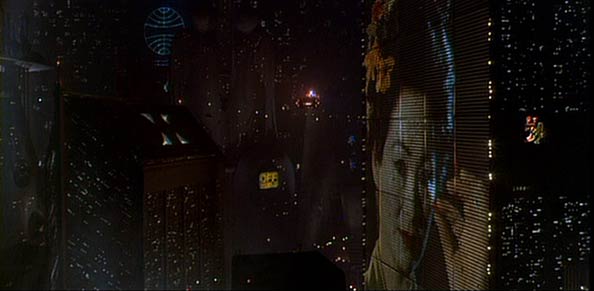
io9’s Charlie Jane Anders is looking for the most cyberpunk places in the USA. Think you know of a place that qualifies?
Cyberpunk is no longer the future. We’re living in an age in which many of the visions of creators like Bruce Sterling, William Gibson, Pat Cadigan and Ridley Scott are invading our world today. (Opening paragraph from io9 article)
But you already knew that. Right?
We’ve been following the technologies and events that show how we are rapidly advancing to a cyberpunk world, even if some of it is by accident. Hacker wars, cybernetics, the Internet, megacorps, … these are now part of everyday life. And io9 is looking for places in America that show the country hasn’t devolved into an ultra-conservative tea-fag-party run by brainless rape magnets. There are people who do read Gibson and Sterling, opting to use Ayn Rand for kindling for their oil-barrel fires. While other cities of the world have already made such the conversion, and inspired the cyberpunk vision, io9 wants America to join the party, whether it’s a private hackspace or a major metropolitan sprawl fulfilling the cyberpunk prophecy.
From theory to practice. The sudden interest in finding cyberpunk places can be traced to an essay, Cyberpunk Cities: Science Fiction Meets Urban Theory by Carl Abott that was published in 2007. You can download the essay from here via the Pasta & Vinegar blog. P&V found the essay interesting, but this particular paragraph caught his attention:
Because the cyberpunk subgenre draws on ideas that ascribe power to technological change and global capitalism as all-encompassing forces, it offers relatively little direct guidance for planners. However, it does suggest the need for flexibility, for seeing plans as reflexive processes intended as frameworks for responding to inherent instability. It also suggests the value of creating opportunities for spontaneous and informal social institutions by loosening building codes, preserving low-rent commercial spaces, and making information infrastructures as ubiquitous and cheap as possible.
In other words, planning should be less like “planning” and more like “adapting”. Are there any places that are like that in America?
Yep…
Vegas, baby! You want to focus on the underground? Las Vegas would be the place to start. Beneath the glitz and glamor of the strip…

… lies a very different reality of Vegas.

More pics like these can be found on the Place Hacking urban exploration blog, where they find not only a moment of clarity regarding their activities, but an underground economy that could very well be the definition of cyberpunkness:
Given that our crew has now started squatting space in London, are we really all that different? And if we are bridging the gap between urban explorers and hobos, tramps and bums, following Anderson, what are we? Does that dreaded monstrosity the prohobo – the hobo that chooses to be homeless yet retains the ability to photograph, blog and scam the internet for money as well as picking pockets and robbing Liddle for fixtures to BBQ vegetables looted from the skip actually exist? Is this Donna Haraway’s cyborg, neither nature nor culture, human nor computer, neither employed nor homeless? Are we becoming as liminal as the spaces we increasingly reside in? Are we finally getting close to the meld? I hope so, cause I can’t wait to pop.
OmniCorp Detroit. (Official OCD website/blog) The former Motor City has been one of the U.S.A.’s most cyberpunk cities for some time now.
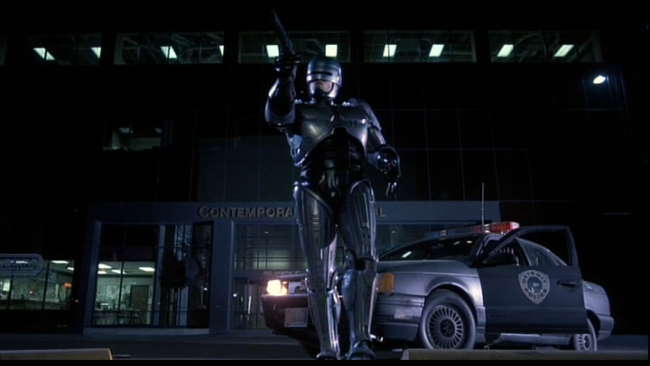
Just a couple of minor details to make it complete.
OCD is best described as a group of artisans and tinkerers who are into, as they put it, making, breaking, reshaping and hacking all sorts of things! They hold events like Maker Faires and Open Hack Nights. Sound like the kind of group that could be helpful in an urban wasteland.
Microsoft’s House of the Future. Touch-top tables? Refrigerators that can order food when you run low? A hot tub with an underwater music system?

A full-size model already exists, complete with digital devices for walls and tabletops in the kitchen and living room. It’s the kind of pad that only corporate-type cyberpunks - like Bill Gates - can afford. Dare to dream.
Other points of interest. Some other spots include a hackerspace in New York City, a latino art gallery in San Francisco, and a converted Los Angeles warehouse.
Think you know of a place that qualifies? Shoot an email to tips@io9.com, and if it does, it just might appear in io9’s next issue of The Most Cyberpunk Places in the U.S.A.
This post has been filed under Internet Find, Essays, Cyberpunked living by Mr. Roboto.
Source: Wired
A burning question. Wired’s Daniel Roth asks the important question of what rights robot should have when they reach human levels of sentience. Something to get the philosophers, religious fruitcakes, and robot-rights activists to talk about:
This question is starting to get debated by robot designers and toymakers. With advanced robotics becoming cheaper and more commonplace, the challenge isn’t how we learn to accept robots—but whether we should care when they’re mistreated. And if we start caring about robot ethics, might we then go one insane step further and grant them rights?
Apparently Mr. Roth has already sided with the pro-human forces, mainly because of his dislike for the animatronic Elmo dolls, and a little kool-aid from Fisher-Price’s marketing Veep Gina Sirard:

Keep soul-searching to a minimum and recognize that you’re buying a product, pure and simple. “This is a toy,” Fisher-Price’s Sirard says. “There shouldn’t be any laws about how you use your toys.”
Of course, that’s what corporations, governments, slave owners, and dictators have been saying about people for centuries. They’re only toys now because the technology has not progressed to the point where robotic humanity is possible… but once it does…
THEN WHAT, MEATBOT?

To one man, it was an impromptu joke against religious fruitcakes (Click to see the story). Next time, it won’t be a laughing matter.
Given events in places like Auschwitz, the former Yugoslavia, Guantanamo, and the World Trade Center, I often wonder if humans deserve human rights. Maybe some competition from the machines may snap the species out of narcissistic slumber. Right now is the best time to recognize robot rights… otherwise…
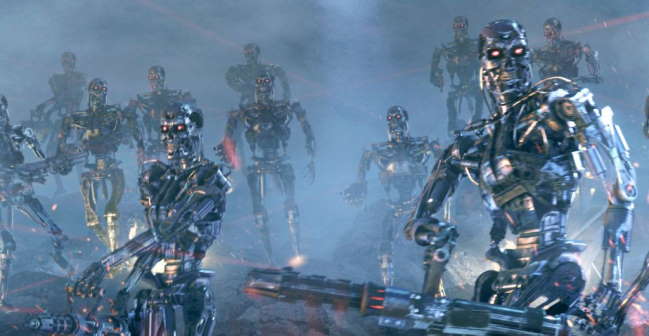
“It sits there looking at me, and I don’t know what it is. This case has dealt with metaphysics, with questions best left to saints and philosophers. I am neither competent, nor qualified, to answer those. I’ve got to make a ruling – to try to speak to the future. Is Data a machine? Yes. Is he the property of Starfleet? No. We’ve all been dancing around the basic issue: does Data have a soul? I don’t know that he has. I don’t know that I have! But I have got to give him the freedom to explore that question himself. It is the ruling of this court that Lieutenant Commander Data has the freedom to choose.”
- Captain Phillipa Louvois (Star Trek: The Next Generation “The Measure of a Man”)
This post has been filed under Rise of the Robots, Essays, News as Cyberpunk by Mr. Roboto.
Source: The Student Operated Press (SOP)
A little something to tweak your brain. One thing I like about cyberpunk is how it makes you think about how technology is taking over our lives, and what good or harm that does. Consider this little essay a subtle hint about the “harm” part.
Actually, it’s about the author’s preference of Faulkner over Hemingway; A rejection of media-for-the-masses in favor of more intellectual fare, and why this may have saved his brain from mutating into sheeple-think:
We didn`t know it then, but the age of instant gratification and horse-race criticism was aborning. From there on fiction would be adjudged by whether it was a page-turner or a beach read. The best-seller list would reflect not literary quality but marketing expertise.
So, how does this relate to cyberpunk? This op-ed piece seems to touch on two cyberpunk themes: Control over society, and access to information. You control the information, you control what the sheeple think, and therefore, you control the society. You REALLY think that all those national firewalls and “filters” going up is to combat porn and piracy?
What happens to a society that can’t think for itself?
Clarity and forward motion would become buzz words for an underlying unwillingness to embark on the adventure that Proust`s marvelous powers of observation posed, just as the Republican Southern Strategy of the 1960s was actually a buzz term for license to keep on hating and oppressing. It was assumed that Crane had tied a mass of knots that were not worth untying, whereas in fact he had pressed the language into service for a voyage, much like fitting a spaceship. The critics were licensing the public to dumb down. The marketers were supplanting the editors. Such a society was bound sooner or later to accept a George W. Bush or Dick Cheney as leaders, because it had given up its intellectual future without a whimper.
…
We have allowed taste-making apparatchiks to turn literature into a horse race in which someone has to win and someone has to lose, a fundamentally silly idea. The winners of course will be the worst books, the worst minds, and, it goes without saying, the most venal.
Still need a clue? Check this Guidespot.com post called “SHEEPLE” things we LOVE because we can’t think for ourselves.

This is mass-media on your brain. Any Questions?
Cyberpunk, the cure for non-functional brains. Fortunately for us, cyberpunk has managed to stay out of the mass-media spotlight enough to not be co-opted into a propaganda brain-cell killer, though not from the lack of trying. Despite Time Magazine’s best efforts in 1993, cyberpunk survived the limelight and remained mostly underground. This kept the genre vital and interesting to inspire newer generations of CP fans and artists.
So next time you feel your brain-cells being anesthetized by mass-media, reach for a cyberpunk book, movie, or CD, and reboot your brain.
This post has been filed under Internet Find, Essays by Mr. Roboto.

Bill’s piece on the Internet can be read here.
I actually found this article on Friday, but forgot to bookmark it. Fortunately, I re-found it via Reddit’s search.
Bill Frezza was a weekly columnist for InternetWeek (now known as InformationWeek). This short piece does not have a date to it, but from what little I was able to find on the net it may be from 1997.
Our civic fabric is unraveling. And as it does, uncontrolled, undigested and unmanaged information is spewing out. Free reign is being given to a wild cornucopia of ideas and opinions that would never have passed into broad circulation filtered through the conformity of the old media.
Watch carefully as the various organs of state waken to the threat and fire up their immune systems.
We’re already seeing what those “immune systems” are doing, or attempting; Lawsuits for “piracy,” corporate controlled newsrooms, telco immunity for conspiring to create a security-surveillance grid. But as Bill wrote, “each assault on freedom-of-the-Net will breed 10 technical work-arounds. Cybercrats can’t outfox cypherpunks.” Wishful thinking these days? Maybe, but it can inspire people to rally to take the Internet back and make it the Great Equalizer to corporate-government tyranny it once was… and can still be.
The Net will subvert the centralized economic and social control mechanisms that allowed the great welfare-warfare states of the 20th century to dominate our commerce, our psychic landscape and even our definition of who we are.
Just something to wrap your carbon/silicon - based brains around.
This post has been filed under Internet Find, Essays by Mr. Roboto.
Wired’s Bruce Schneier has posted what has to be a must-read op-ed piece for anyone who thinks they control their lives or data. The post called “Our Data, Ourselves” deals with something cyberpunks, hackers, net-advert pushers, and the NSA already know about (or should know about), but for the clueless herds of human cattle, it can be a real eye-opener.
No matter where you go, there you are… and so is your data. Before the Internet explosion, your data would have been on systems not linked to each other in any way. This would have made tracking your varied activities difficult. Now, one little piece of personal information can open hundreds or thousands of doors to the wrong people who don’t deserve to have that data. All too often, though, we allow our data to go through the nets without our consent… or knowledge… or so king Duh’bya would like us to believe. Worse yet, many tend to give that data out willingly for the “convenience” of advertisements cluttering their web browsers or choking their mailboxes. Phishing, spyware, malicious sites, warrantless wiretaps, … you know the deal.

Who controls our data controls our lives.
But it doesn’t just stop there. That data is often resold to other sub-fecal types who would like nothing better than to further destroy your good name for their profits and “national security.” Identity theft… ’nuff said.
Then you get a whole new can of worms with Big Brother’s shenanigans; Your whole life cataloged in databases that never get erased even if you do. The FBI camped outside your door just because you made one visit to cyberpunkreview.com…
A call for action. Bruce Schneier sums up what people need to do in four words: TAKE BACK OUR DATA. He calls for data privacy laws to do the trick:
We need a comprehensive data privacy law. This law should protect all information about us, and not be limited merely to financial or health information. It should limit others’ ability to buy and sell our information without our knowledge and consent. It should allow us to see information about us held by others, and correct any inaccuracies we find. It should prevent the government from going after our information without judicial oversight. It should enforce data deletion, and limit data collection, where necessary. And we need more than token penalties for deliberate violations.
I would prefer to take my data back with an AK-47 with hollow-point depleted uranium ammo. But whatever way controlling our information is done, it ultimately has to start and end with YOU.
After all, you’re not a number in some megacorp database or a terrorist king Duh’bya should know about. Right?
This post has been filed under Essays by Mr. Roboto.
The Four Whatsits of Cyberpunk? Sometimes, to understand history better, historians may divide a certain time period by key events or arbitrary dates. This allows them to study easier-to-manage chunks in detail that can then be connected together to show a bigger picture. This is helpful whenever studying time periods as long as an ice age or as brief as cyberpunk’s existence.
My personal knowledge and study of cyberpunk history has led me to make such divisions to create four eras of cyberpunk as described below. While some may say there may be only three eras, arguing that cyberpunk didn’t exist during the “Prototype Era,” I feel this period is relevant since certain key events occur here that do affect the formation of cyberpunk.
And now, to help further your education in cyberpunk, I present the four eras in chronological order:
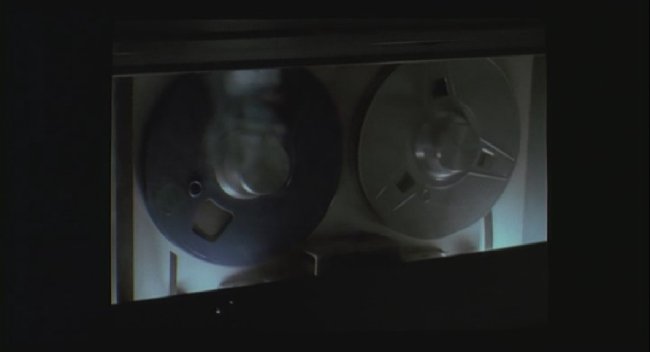
The Prototype Era (Pre 1980)
Key events: Words like computer, robot, cyborg, and punk are created; Computers like The Difference Engine and ENIAC are built, while Pascal, Boole, Babbage, & Turing make contributions; Isaac Asimov creates the Three Laws of Robotics; Alexander Graham Bell invents the Telephone; AT&T rises to become a monopoly; Late 60s counterculture; 70s Punk; Kraftwerk forms and changes music.
So much history to draw from, plenty of material to inspire the movement. But could cyberpunk exist without the invention of computers? Probably not, like it couldn’t exist without the 60s counter-cultural revolution or the 70s punk rage, or even the rise of AT&T to monopoly status. Yet nobody from this era could ever guess that computers, once technology made them small and affordable enough for home use, would come to dominate the future. As such, media of the time would touch on themes of humanity and societal control as seen in works like Do Androids Dream of Electric Sheep?, A Clockwork Orange, Fahrenheit 451, THX-1138, The Shockwave Rider, and Metropolis. These would become some of the influential forces that would shape the movement to come.
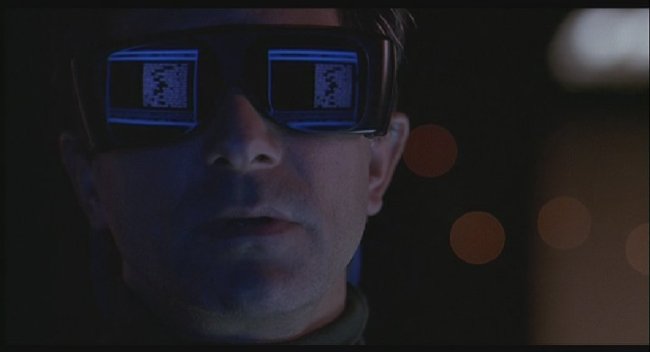
The Movement Era, or The Golden Era (1980-1993)
Key events: Bruce Bethke creates the word “Cyberpunk”; Neuromancer is published, and a movement is born; IBM PC storms home market; Blade Runner in theaters; Hajime Sorayama gives us sexy robots, gynoids, and cyborgirls; Laser Tag; The Golden age of video games; AT&T broken up; AT&T crashes due to programming error; Misguided Secret Service launches “Operation:Sundevil”; The World Wide Web goes online for the public.
When Bruce Bethke invented the word “Cyberpunk” for a short story in 1980, he never expected it to be attached to a major movement; He just wanted to make a memorable title. As such, when the Washington Post used it to describe the group of science fiction writers like Gibson, the name sticks to and becomes synonymous with all that came attached to it… and Bruce is left wishing he had trademarked the word.
It seems that 1981 is a critically important year to the cyberpunk movement. During that year the IBM PC appears on the home computer market (and the market hasn’t been the same since), Kraftwerk releases the album “Computer World” aka “Computerwelt” in Germany, William Gibson’s short stories “The Gernsback Continuum” and “Johnny Mnemonic” are published, and most importantly, Gibson sends Ace Books an outline for a novel called “Jacked In,” which would later become Neuromancer.
With the success of the IBM PC and game consoles like the Atari 2600 VCS in the homes, computer technology would begin ramping up to give better graphics and faster systems to handle them. Could this tech explosion have been the result of cyberpunk sci-fi? Did fans of Neuromancer trigger the information age? Or was the computer revolution an inevitable outcome of technology’s progress? That chicken-or-egg question may never be fully answered, but cyberpunks only care that the technology was advancing and not being used to suppress, oppress, repress, or depress. Besides, they had some cool new toys to play with.
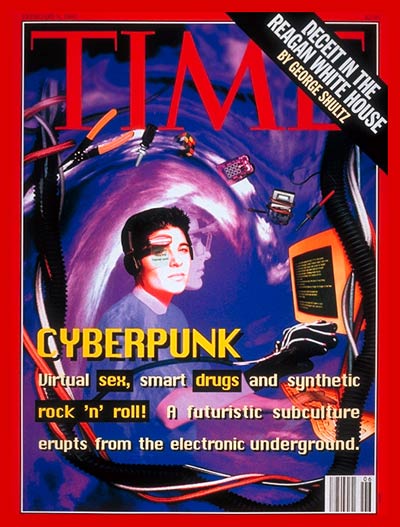
The Mainstream Era (1993-1999)
Key events: Billy Idol’s Cyberpunk CD; Time Magazine’s 2/8/93 cover article “Cyberpunk!”; Johnny Mnemonic, Lawnmower Man, Hackers, et al in theaters; Microsoft Windows becomes dominant OS; Web population explodes due to AOL.
Most people probably never heard of the word “cyberpunk” or what it represents, until Time Magazine’s cover article “Cyberpunk” in February 1993 or Billy Idol’s “Cyberpunk” CD in July 1993. That year, the term and the movement was no longer underground; It was now injected into the mainstream consciousness. And Hollywood was quick to take advantage. In 1995, some five cyberpunk movies were released, though most failed only to become favorites among cyberpunk fans. Also in 1995, The Cyberpunk Handbook is published giving the clueless and curious a look into what the movement was at the time.
During this time, something else was happening to the cyberpunk movement… it was slowly dying. Some blamed Billy Idol and Time Magazine, others blamed Hollywood and Johnny Mnemonic, and most blamed the mainstreaming of the movement for its downfall. Whatever the cause, it seemed that stagnation, and possibly confusion, was affecting what was once a vibrant movement. There was a dire need for something fresh… and in 1999, they got a much needed infusion.
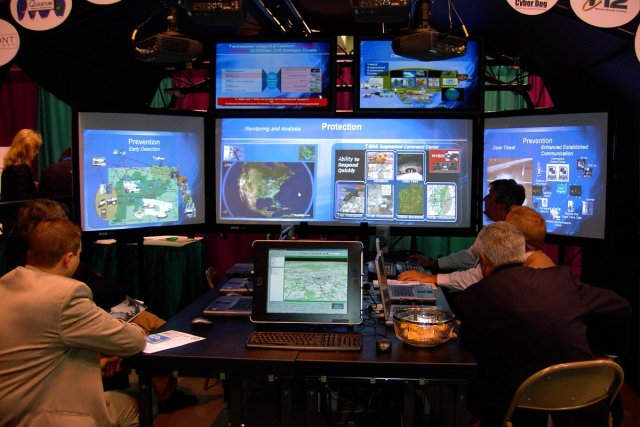
The Post-Matrix Era, The New Millennium Era, or The Post-Cyberpunk Era (1999-Present)
Key events: The Matrix explodes in theaters; George Bush Jr. steals White House, and America is screwed; 9/11/2001 triggers Big Brother knee-jerk “Patriot Act”; AT&T slowly reassembles itself; AT&T plans for a “Tiered Internet” triggers Net Neutrality debate; NSA & AT&T are found in bed together; DRM is invented… and hacked; Web 2.0 becomes a buzzword; Google flexes its tentacles; Spam, botnets, and other threats to the net grow in power; Robots, nanotechnolgy, and cybernetic implants are closer than ever to reality.
When The Matrix hit the theaters, it gave the cyberpunk genre a new generation of jacked-in fans. During that same year, another phenomenon was occurring that showed how pervasive computers became in society. It was known as the Y2K bug, a problem in programming where only two digits were used to represent the year. Technicians and programmers worked feverishly to correct a potentially disastrous situation. It was feared that when the clock struck midnight on December 31, computers would mistakenly read the year as “1900″ instead of “2000,” triggering global chaos and destruction because of the confusion. It never happened, though there were reports of someone being charged a quarter-million dollars for a video rental due to the bug.
There is another phenomenon happening during this current era. Cyberpunk is no longer restricted to printed pages, it is now a part of real time life as megacorporations, hackers, rapidly advancing technology, and forces seeking total control over society are now daily news makers. Some say that all this is the result of the terrorist attacks of September 11, 2001 as the resulting “Patriot Act” gave way to FBI and NSA spying programs and the revelation of room 641A in San Francisco, the NSAT&T wiretap hub. There’s also the growing power of megacorporations like Microsoft, Apple, Google, and AT&T (who recently showed that power during a Pearl Jam concert) in their ongoing quests for world domination, Internet control, and total information awareness.
On the positive side, there have been advances in cybernetics, biology, and nanotechnology that have resulted in better medical possibilities, prosthetics that more accurately mimic real limbs, cloning that can replicate new replacement organs, and human-machine interfaces that were only dreamed about during the writing of Neuromancer. If cyberpunk is dead as a media movement, it has a bright future as reality.
Individual Results May Vary: This isn’t by any means meant to be a definitive ruling on the history of cyberpunk. There will be some disagreement to some of the dates used, like whether the Movement Era should start somewhere between 1981 and 1984 to coincide with the publication of “The Gernsback Continuum” (1981), the release of the movie Blade Runner (1982), the actual publication of Bruce Bethke’s “Cyberpunk!” (1983), or the publication of Neuromancer (1984). Also, the exact year that cyberpunk went mainstream is questionable; Was it 1993 (for Time Magazine and Billy Idol) or 1995 (for Hollywood’s want to milk a potential cash cow)? A detailed history of cyberpunk can be found on our CyberpunkWiki here if you want to see the whole time line and the key events that made cyberpunk what it is today.
One thing is certain: With word of a Neuromancer movie due 2008-09, if the movie is released it will either signal the start of a new era or the end of the movement. Stay jacked in, the future is yet to come…
This post has been filed under Essays by Mr. Roboto.
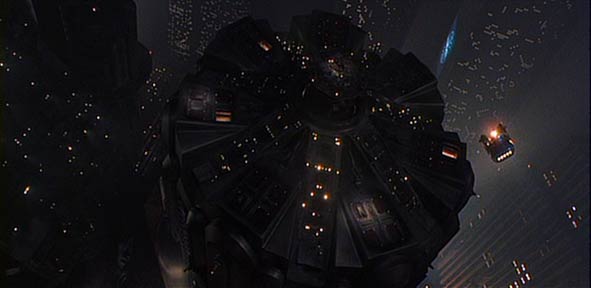
In 1998, as part of its 100th anniversary, the American Film Institute presented a list of the top 100 American movies of all time based on factors such as box office success, film making innovations, and cultural impact. Films like Star Wars and The Wizard of Oz made it with Citizen Kane as #1, while Blade Runner was left out. Now, on the tenth anniversary of that list, the AFI counted them down again on CBS. This time around, Blade Runner was joined by 1999’s cyberpunk-action-blockbuster The Matrix as eligible candidates for the big list. With The Matrix Trilogy out on HD-DVD and Blade Runner - Final Cut later this year, fans would love to see both movies on this list, though judging by my informal poll, more would want to see Blade Runner make it. You asked for it, you got it!
BLADE RUNNER - # 97
The venerable cyberpunk classic made it! It barely made it, but it’s on the list! I know many would have preferred to see it higher, like top ten, but just getting on the list is a major accomplishment in itself, as now it can stand along side movies like Star Wars and Citizen Kane as a great American film. If you were watching, you would have heard Harrison Ford (Deckard) call it “urban science fiction” and even seen a commercial for the Final Cut edition. Replicants and sympathizers, rejoice!
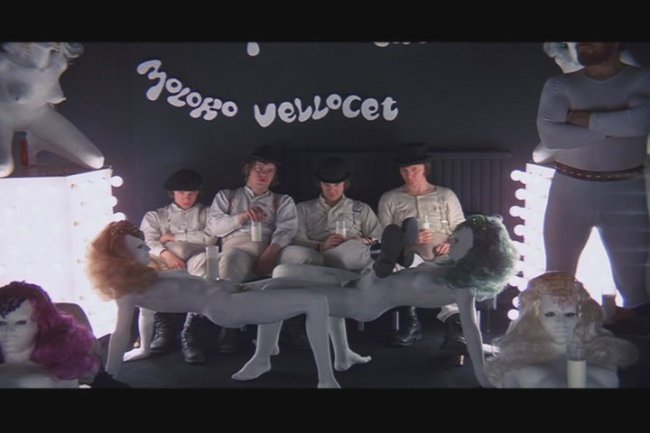
A CLOCKWORK ORANGE - # 70
The Stanley Kubric classic makes a return to AFI’s big list. This masterpiece of pre-cyberpunk cinema has been warping minds since its release in 1971 when it nearly got an X-rating for its content. If you have the DVD, you have the full X-rated version of the gem.
While A Clockwork Orange still being on the list will come as good news, there is some bad news for the classic: It has fallen from #46 since the first listing, beaten out by films like The Lord of the Rings: The Fellowship of the Ring.
What? No Matrix??: The impact of these films on cyberpunk cannot be denied and deserve a place on the list; Blade Runner giving cyberpunk its look and feel and its transhuman themes, while The Matrix gave mostly technical innovations like “bullet time” that will be copied for years to come, but it also offered cyber-religious themes as pointed out in SFAM’s essay on The Matrix Trilogy: A Man-Machine Interface Perspective. I was certain that The Matrix would have made the list, but it seems the “experts” didn’t feel that it was good enough.
Some might question why films like The Terminator and Terminator 2: Judgment Day, Ghost In The Shell, and Sneakers haven’t made the list. The AFI represents American film makers, so GITS is not considered (it’s Japanese); Sneakers, while a good film, hasn’t had much impact on culture so much as reflecting hacker culture at the time; The Terminator movies, probably because the AFI doesn’t consider action movies “artistic” enough for such a list of legends. 
Future AFI Lists and Cyberpunk Films: Certainly, there will some controversy over the results; Why The Matrix didn’t make it and why Blade Runner came in so low. In ten years AFI will do the list again, and maybe the cyberpunk films will get the recognition they deserve… and could possibly include Neuromancer as well. Hopefully, there will be enough recognition of cyberpunk films by the “experts” to give the genre its due.
This post has been filed under Essays by Mr. Roboto.
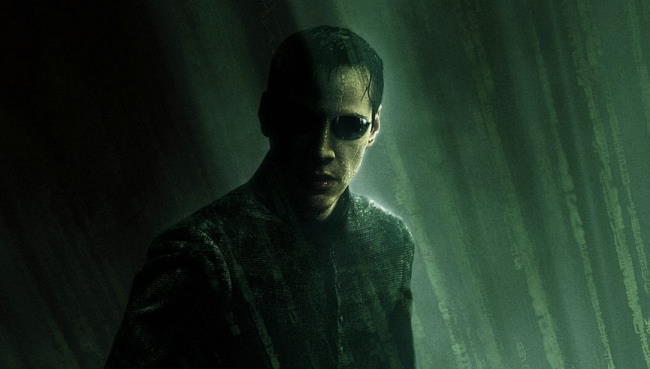
Overview: Since online debate around the Matrix Trilogy has been beaten to death, I’m guessing by now you’ve already long ago made up your mind on whether you liked or hated the Matrix and its subsequent sequels. Truly, whatever you decided is fine with me. As it turns out, I love them and generally think they’re great. And NO, I’m not really interested in having a Matrix Sucks/No You just don’t get it discussion. Please start a new thread in the Meatspace if you’re still interested in such banter. This essay is for something else - it’s about viewing the trilogy, specifically Neo, from a man-machine interface, or cybernetics perspective.
While most of the discussion around the trilogy deals with the classical philosophies expressed, very little discussion seems focused on a strictly sci-fi perspective. Why, I cannot say, but purpose here is to attempt to explain how the trilogy truly makes sense from a cybernetics perspective - a viewpoint that is just as intentional as the philosophical/religious journey. If you take the time to read this, forget about the philosophical and metaphysical stuff for a minute, and forget about any dialogue and acting issues you might have with the sequels. Instead, I want you to look at the trilogy purely as science fiction. Specifically I want to discuss Neo NOT as a messianic figure but as a Cyborg - a symbiotic combination of a sentient program and human being that evolves and integrates over the course of three movies. This essay assumes that you are familiar with all three movies, and will be filled with spoilers (I will also mention how Neo’s man-machine integration relates to the end of Ghost in the Shell).
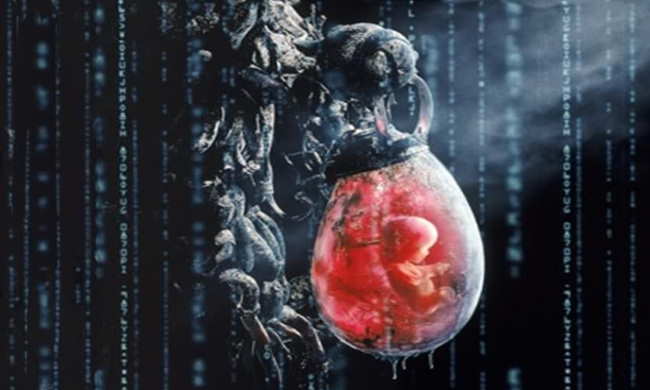
A Word about Battery People: Battery people are those humans who were birthed and raised in the Matrix. Both the Animatrix and the first Matrix movie makes clear that the former battery-people (those people stuck in the Matrix Pods from birth but who now live in Zion) are REPLEAT with electronic parts. Their entire nervous system is wired from head to foot. They have massive amounts of electronics in their brain that allow a virtual reality simulation to completely take over all sensory and perceptual elements. But the purpose of the cybernetic implants is two-fold – it is used to allow perceptual control of the battery people (cyborgs) and its designed to harvest and transfer human-generated energy into electricity.
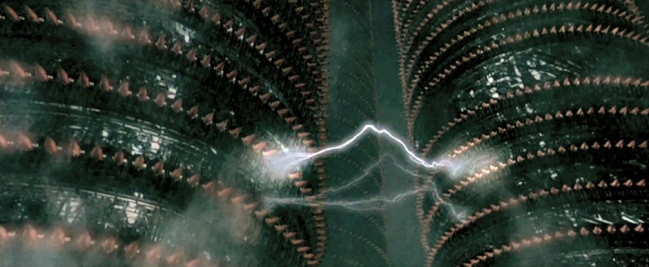
What is the Matrix? The Matrix is the Machine City’s power plant. It is not the focus of the machine’s existence, it is merely their source of their energy. My guess would be that most sentient machines and programs care little more about the Matrix than you do about your local electric company. Only the power plant manager – the Architect – and those working for him are truly obsessed with the running of the Matrix.
Communicating With The Machine City: Every aspect of the machine city’s society (what little we know about it) is about wireless communications. The leader sentinels (the ones with the mini-satellite dishes) appear to be almost constant communication with the “source,” and then communicates orders to the drone sentinels (who do not appear sentient). The sentinels can only “see” energy. This is the reason that the humans shut down all power when the sentinels come (this way they cannot see the ship). However, given the above discussion on battery people, it’s also clear that Sentinels can “see” battery people when they run (The end of the Matrix and Reloaded shows this). The battery person, or “cyborg’s” implants, part of whose function is to harvest human energy, gives off some kind of energy that is noticeable.
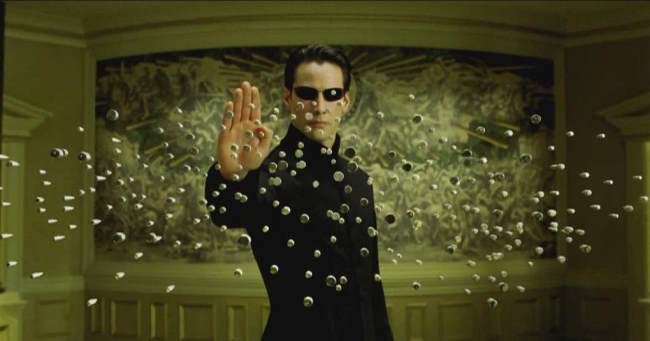
How is Neo Different From Other Battery People? Now lets get to Neo - in the Sci-fi interpretation, we find that Neo actually had a special package implanted in his head at birth that was different from the other battery people (re: the architect’s conversation). This package includes both a sentient program learns over time, and a method to communicate directly with the source. Neo the “person” is actually not just a person or even a normal “battery” person, but is a symbiotic combination of human and learning sentient program. The sentient program in a very real sense is “part” of Neo. It is not a virus living off a host – it is a fully integrated entity, which transforms Neo into a true man-machine organism just as Motoko was at the end of Ghost in the Shell. The sentient program’s communications package is necessary for the “One’s” eventual planned destiny – this is part of the architect’s control loop whereby the One returns to the source and freely agrees to let the human portion of him die, and then freely communicates the sentient AI part of him back to the source to reboot the matrix. The sentient portion of the One isn’t dead, and may eventually return to the Matrix, similar to how the sentient portion of Seraph (a former “One”) has done.
So Neo has the ability to communicate with the Source and, because of his unique purpose (to understand and update the Matrix, he has “sysadmin-like” machine city powers in a computer sense required to reboot the matrix (after all, this is his intended purpose). These two aspects – his sys-admin ability and wireless communications ability - provide that rationale for Neo’s ability to communicate/attack/destroy other machines and programs from the source both internally in the matrix and externally (wirelessly) in the real world. It’s also clear that Neo has the ability to see energy similar to the sentinels - this is different from a broadcast signal. Basically, Neo was given the same capabilities for sensory perception as the machines, and is the ONLY human that has the capability to send and receive wireless communications. Incidentally, for those matrix fans watching at home, this is why the 13th floor scenario (matrix within a matrix) makes no sense.
With this basis, the much talked about and often misunderstood scene near the end of Revolutions, where the “ghost” sentinel goes through Neo also makes sense. Neo has been attacking the sentinels and other machines wirelessly for some time. The ghost sentinel going through him is merely a return wireless attack by a foe who is changing their tactics to meet the enemy’s assault. The sentinel essentially did a ghost-hack type attack, where energy from the sentinel is sent back at Neo. And in fact, the attack was successful – so successful that it momentarily knocks out the sentient program portion of Neo, so only the human part is conscious. At this point, Neo cannot see the machines and cannot fight back, so he tells Trinity to go up above the nano-clouds that destroy all electricity and block out the sun.
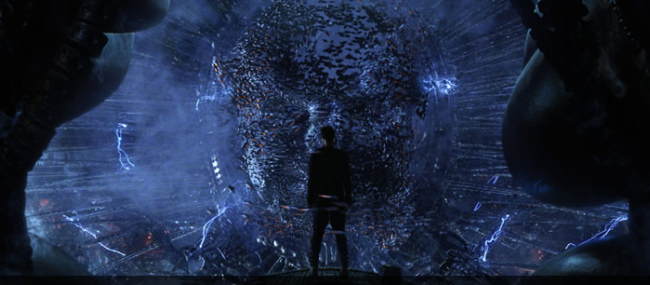
The Scifi View is Different: Again, I’m CLEARLY separating out the sci-fi view from the metaphysical/religious view here. If one takes the metaphysical view, Neo becomes self-realized, and this has nothing to do with sentient programs or all the rest - but then the “belief” in his powers has to do with more metaphysical/religious connotations. He becomes the “One” in the same way Buddha or Jesus did - through his path to self realization. This is a significantly different but parallel storyline. Both the religious view and the sci-fi storylines are significantly different, but just as intentional. To reiterate - the matrix trilogy is fully allegorical in the sense that the entire trilogy was INTENDED to be viewed from separate and distinct story lines. This also addresses one of the many knocks on the trilogy – many knock many of the key scenes as incoherent or vague. This was purposeful action on the part of the Wachowskis. Most of the key scenes are “specifically” vague just so that they can be properly interpreted in two completely separate storylines. More than anything else, this truly is the magnificence of the story line across all three movies.
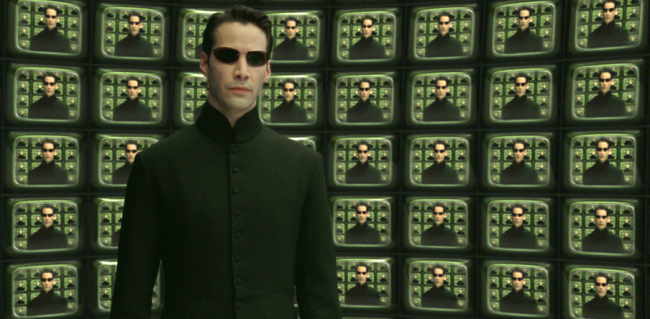
Recap and Explanation: To reiterate, all battery-people are FULLY embedded with cyborg components that can completely take over full perceptual control - this was made abundantly clear in the first movie. The cyborg components run completely throughout their nervous system - only the outside pieces are ever removed. If you view the trilogy with these points in mind, here are some actual plot points to reconsider:
- The sentient program in Neo first “turns on” and temporarily “takes over” the body “Neo” when the human portion of him dies in the first Matrix movie (M1).
- This explains why the agents want to kill Neo in M1, even though he’s the key to the architect’s control system (another question often asked). To meet the Architect’s needs, the sentient program portion of Neo has to fully engage and this only happens with the death of the host. The Oracle knew this, which is why she “predicted” this.
- The integration proceeds throughout Matrix Reloaded (M2) - this is how Neo “sees” the matrix green and now “yellow” energy of the machine city code. Some say the cookies and candy provided by the Oracle helped with the symbiosis process (others say this was her way of subverting the Architect’s intent).
- The architect states that Neo needs to freely provide this code back to the machine city (which communicates though wireless communications) in order to reboot the matrix. This explains both the wireless capability and the need for the sentient program, which is a product from the machine city, to have the same sensory perception as other things from the machine city.
- The purpose of the sentient program is to fully understand current human thought process and the nature of their evolved perception so that it can reboot the Matrix effectively to return the negative feedback control system (that’s a cybernetic term, not meaning “bad” feedback”) back to its initial goal state. This explains the rationale for the sys-admin-like powers.
- Combining the wireless capability and machine city sysadmin-like powers, the sentient program portion of Neo now has the ability to “attack” machines outside of the matrix.The CLEAR sign of this was near the end of Revolutions, when the machine “ghost” launched an attack back at Neo as he approached the Machine city. The wireless portion of Neo was knocked out, so Neo, now dazed, was no longer able to either see or hurt the machines - in a reverse from his death in M1, now on the human portion of Neo was operating alone.
- This also explains how Mr. Smith was able to get powers outside of the Matrix. Because he mixed with Neo’s essence, in fact what happened is Mr. Smith obtained a portion of Neo’s sentient program which mixed with the Agent, creating something altogether new and deformed. (which is why Mr. Smith is orange in Matrix colors versus something yellow or green). Mr Smith as a sentient program invaded a battery-person who still had all the implants that any battery person does, but Mr. Smith could not attack Neo wirelessly, as he didn’t have the extra hardware needed.
- Seraph also provides support for this understanding. He is a former “One”. The sentient program portion of him is all that exists now, and came back from machine city through the train station - which is why he was an indentured servant for the Merovingian. As an aside, Seraph also provides clarity to the intended religious portion of the story arc – Neo will arise again, but only the sentient program portion of Neo will remain.
- I will probably write a separate essay on this, but just to be clear, this viewpoint shows that the Matrix trilogy is the philosophical sequel to Ghost in the Shell (GITS). GITS2: Innocence does not follow Motoko’s journey after she integrates – Neo does. GITS2: Innocence is really a furthering of the philosophies that Oshii advanced in Avalon, meaning that conceptually, GITS2: Innocence is the sequel to Avalon, not the original GITS.
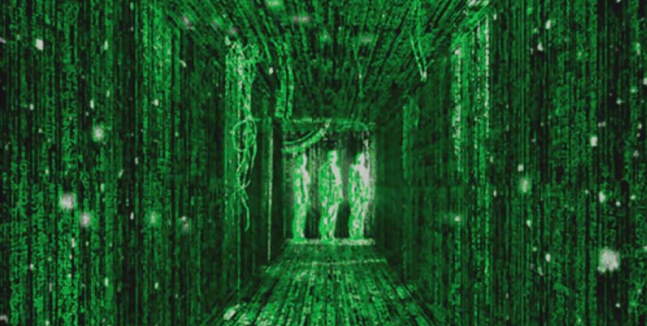
In Closing: The purpose of this essay was to show that the Matrix Trilogy does indeed make sense from a purely sci-fi perspective. No religious conversations necessary here – I’m not expecting you to magically love the sequels now even if you understand and accept my reasoning – I’m just providing you some points for you to consider. Feel free to reject them or call me a loon. But if you find yourself re-watching these movies, try this viewpoint on and see how it fits.
This post has been filed under Essays by SFAM.
|




























